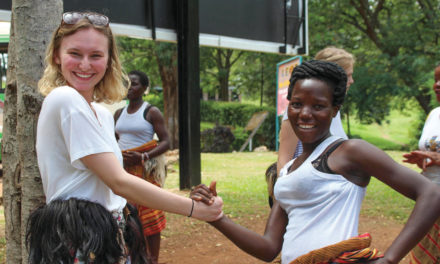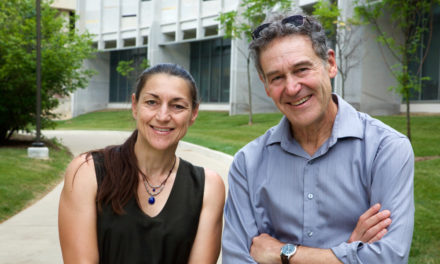
Katy Börner with Amatria, a “sentient sculpture” her team helped create. Photos by Jim Krause
BY PETER DORFMAN
Indiana University Professor Katy Börner has built a career developing tools to manage complexity—tools that help people make decisions or simply navigate the noisy, confusing landscape of 21st century society.
Börner is the Victor H. Yngve Professor of Engineering and Information Science at the Department of Information and Library Science in the Indiana University School of Informatics, Computing, and Engineering. As well, she directs the Cyberinfrastructure for Network Science Center at IU. Her specialty is data visualization, a discipline that aims to simplify and extract meaning from large volumes of information.
Börner also heads an Intelligent Systems Engineering team, building machines that consume data from sensors embedded in other devices, all communicating via the so-called “internet of things.” Working with Canadian architect Philip Beesley, her team helped create Amatria, a “sentient sculpture” that hangs in the fourth floor atrium at Luddy Hall, the IU informatics building that opened in January. Through 600 sensors, the massive sculpture observes and responds to the behavior of humans who walk under it. The behavior of Beesley’s sculpture will change over time as its internal AI learns the way human visitors act.

Amatria hangs in Luddy Hall on the IU campus.
Börner offers that a map is a simple example of data visualization. But mapping applies not just to places in the geospatial world, but to complex relationships between ideas and things that exist only in a virtual sense: organizational structures, laws and customs, interpersonal relationships, and so on, Börner explains. “Mappings help people who work in very different fields understand each other.”
Börner, 50, has written several books on these kinds of visualizations. And while they include two-dimensional mappings on paper, much of her work has focused on the use of computers to enrich data and use it to provide meaningful insights.
Growing up in pre-unification East Germany, Börner studied electrical engineering and earned a Ph.D. in artificial intelligence. Her interest in data visualization originally grew out of a desire for better ways to interact with AI and virtual reality systems.
A core goal has been to help people understand the way science and technology influence their lives. “We would like to develop and serve a daily science forecast, very much like a weather forecast for a popular audience,” she says. “It would show where the funding is going, and where the benefits to society will come from.”
As for her sentient sculpture, Börner says, “We hope Amatria will bring more people from Bloomington to Luddy Hall. Many of the exhibitions and symposia here are open to the public.”

Close Up of Amatria










